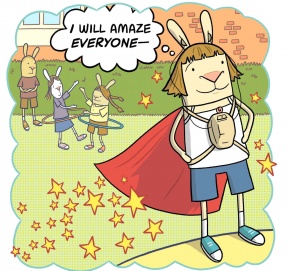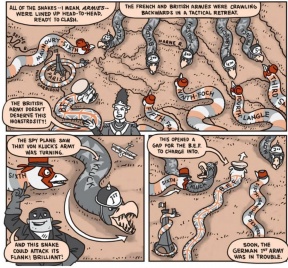This week, we have glanced at the six Eisner nominees for Reality-Based Work in 2015, trying to distill an essence of how reality appears in comics. Looking over the titles, I am again struck by their range, as small as a single childhood and as global as the Great War. I’m reminded of the singular power of comics to infiltrate our consciousness, to suffuse our imaginations, to inculcate us with pictures of the world, even idealized ones. In fact, I’d argue that this idealization, the adherence of comics to symbol, myth, and interpretation, are exactly what makes them such potent conveyors of reality.

Yes, what I’m saying is that comics are good at un-reality, which is what makes them good at reality. In her autobiographical ‘El Deafo,’ Cece Bell as a child reimagines her hearing aid as a superpower and herself as the titular superhero El Deafo, facing down her every moment of vulnerability with superhero courage. There’s a reason comics are the primordial soup of superheroics, where the Extraordinary leaps into the lives of everyday people. Comics introduce (or re-introduce) reality to us in an inextricably and recognizably imaginative form, and often, that’s just what we need.
Because of what I call comics’ tensile strength, how they can stretch our imaginative boundaries without straining our sense of belief, they have the ability to transport us in unique ways other media can’t quite do. Comics blend language, image, and sequence/ juxtaposition, trading on some of the tools of prose, visual arts, and cinema, but circumventing some of those other media’s limitations.
They are awash in language—spoken, narrated, onomatopoetic—but not dependent on it. Tim O’Brien’s short stories about war capitalize on the force of silence in the battlefield, but can’t do so in the same spare way some of the haunting scenes in “To End All Wars” by Hanninen and McClements or John Stuark Clark and Sarah Jones do. Comics can dwell in the words and the silences of reality.

They traffic in the iconic and symbolic power of the kind of visual representation innate to our mental schema, but they get to put those representations into motion, introducing dynamism and narrative. Minard’s famous infographic visualizing Napoleonic invasions is brilliant coordination of relative space, visual contrast, and text, but “Nathan Hale’s Hazardous Tales” can represent the encroachment of French, British, and German armies as snakes on a map (!) getting outflanked as they retreat from one panel to the next. Comics can give movement to the mental images we use to make sense of the world.
Yet despite this capacity for movement, comics are not bound by the controlling obligation of film to replicate experiential time and fill visual gaps, and therefore they can bank on the reader’s imaginative closure in the gutters. MariNaomi’s “Dragon’s Breath” rubs away the hard boundaries between her narratives and our consciousness by virtue of how terse and evocative her visuals and narratives can be, unfettered by the rhythms of cinematic pacing or screen-filling context. Comics can bank on literacy’s effect of granting the reasoning powers to the readers, calling for their imaginative engagement.
Because of these attributes, because comics are so much like thought, I’d argue, they have a unique ability to worm their way into our imaginations, and therefore to palatably and credibly present some of our most incredible notions. As Pulitzer-winning novelist Junot Diaz says, “Suddenly, X-Men seems to you like a message from a better universe.” They can so effectively parallel our personal experiences of reality, yet deliver so believably the possibility of alternatives.
That’s why the name of the Golden Age superhero created by Michael Chabon’s protagonists in The Amazing Adventures of Kavalier and Clay is The Escapist. Comics are a port in the storm for people buffeted by their realities. They pull us into alternate dimensions, nobler adventures, or extreme circumstances we can enter safely because we trust in their authorship. They can do so through the engrossing participatory demands of reading, the intoxicating suggestiveness of graphic depiction, and the conjuring forces of language. In our lives wrung out by the grinding tensions between the realities that surround us and the gossamers of our interpretations and perceptions, we ache for worlds where our restive imaginations can be unmoored, flowing, wild. Comics are wonderful escape.
Continued belowBut if so, why reality-based works? All three of those words—“reality,” “bases,” “work”—clang against this notion of comics as improvisational flights of fancy. It’s true, there are people who want their comics to alert them to reality about as much as they want their burger joints to nourish their celery cravings. They’ll keep their distance if MariNaomi’s “Dragon’s Breath and Other True Stories” doesn’t actually feature any dragons and none of the costumed heroes in ‘Hip Hop Family Tree’ actually acquire superhuman gifts. And that’s just fine.

However, I think most of us readers looking for a great escape know we’re also looking for something more. In “El Deafo,” at the point where Cece gradually reaches adolescence, her caped superego pronounces to her, “YOU don’t need superpowers to speak!” and Cece mounts the voice and courage to take the initiative on an important friendship. Her evolution reminds us that imaginative escape has a purpose and a place. Not that it’s kid’s stuff, rather that its function is not just to extract us away from the clutches of reality, but to lift us far enough off the ground to see reality with new clarity and perspective, and perhaps to re-engage it on different terms. We grasp on to stories and representations not to flee the world but to understand it, perhaps to alter it, or at least to alter the way we understand it.
What do our nominees show us about how this re-engagement might look? It might appear that the two groupings of these books, the autobiographical (MariNaomi, Bell, and Chast) and the historical (Hale, Piskor, and ‘To End All Wars’) represent two different kinds of “reality,” maybe subjective memory and factual information. But the ways these books present their realities resist that dichotomy. History as told by comics is meant to be lived in, wedded to characters’ experiences, layered with diverse sources and glosses, inescapably interpretive. Meanwhile, the subjectivity of autobiographical comics leaves us with few factoids useful for a dinner party, but plenty of stories that wend their ways around those social and personal truths that bind us in shared human experience. Is the personal reality of elder-care and elder-quirks in “Can’t We Talk about Something More Pleasant?” any less real than the historical reality of the cultural fabric woven by Def Jam records described in “Hip Hop Family Tree?”
Whether historical or autobiographical, comics have the weakness AND strength of being suffused in subjectivity. This subjectivity might mean many layers of distance from direct contact with reality. But as stories unabashedly about representations, with less pretense of the grand ghosts of Truth, comics therefore have the potential to unpack the subjectivity in all history and the history in all subjectivity, to tackle the real with creative flair and to ground our flights of fantasy in the gravity of reality.
If you’ve missed any of Paul’s reviews of the 2015 Eisner Nominees for Beas Reality-Based Work, they can all be found here.





